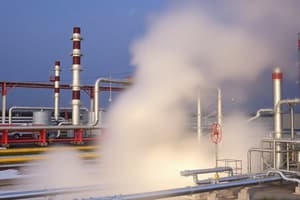Podcast
Questions and Answers
What is the primary atmospheric pollutant being discussed in the article?
What is the primary atmospheric pollutant being discussed in the article?
- Sulphur Dioxide (SO₂) (correct)
- Carbon Dioxide (CO₂)
- Methane (CH₄)
- Nitrogen Oxides (NOx)
What is the primary mechanism by which declining sulfur dioxide levels contribute to increased methane emissions?
What is the primary mechanism by which declining sulfur dioxide levels contribute to increased methane emissions?
- Sulfur dioxide acts as a catalyst for methane production, and its removal leads to a decrease in this activity.
- Decreased sulfur dioxide alters the balance of bacteria in wetlands, favoring methane-producing microbes. (correct)
- Increased CO₂ levels directly stimulate methane production in wetlands.
- Decreased sulfur dioxide allows for increased decomposition of organic matter, leading to higher methane emissions.
What is the predicted impact of declining sulfur dioxide levels on global methane emissions?
What is the predicted impact of declining sulfur dioxide levels on global methane emissions?
- A decrease in methane emissions initially, followed by a significant increase later.
- A significant reduction in methane emissions due to the decreased sulfur dioxide.
- A substantial increase in methane emissions, exceeding previous projections. (correct)
- A negligible effect on net methane emissions.
Which of the following is NOT mentioned in the article as a factor contributing to increased methane emissions from wetlands?
Which of the following is NOT mentioned in the article as a factor contributing to increased methane emissions from wetlands?
How does this research relate to the Paris Agreement on climate change?
How does this research relate to the Paris Agreement on climate change?
What is the primary takeaway from this research regarding air pollution control policies?
What is the primary takeaway from this research regarding air pollution control policies?
Based on the article, what does the term "double whammy effect" refer to?
Based on the article, what does the term "double whammy effect" refer to?
What is the significance of the journal "Science Advances" in this research?
What is the significance of the journal "Science Advances" in this research?
What is the main finding of the study discussed in the text?
What is the main finding of the study discussed in the text?
Which of the following factors contribute to the increased methane emissions as a result of reduced sulfur pollution?
Which of the following factors contribute to the increased methane emissions as a result of reduced sulfur pollution?
Why is methane considered a more potent greenhouse gas than carbon dioxide (CO₂)?
Why is methane considered a more potent greenhouse gas than carbon dioxide (CO₂)?
What is the 'termination shock' effect described in the text?
What is the 'termination shock' effect described in the text?
What is the 'global methane pledge' and what is its goal?
What is the 'global methane pledge' and what is its goal?
What is the main concern raised about the 'termination rebound' effect on methane emissions from wetlands?
What is the main concern raised about the 'termination rebound' effect on methane emissions from wetlands?
Why is the removal of sulfur from the atmosphere compared to removing a 'lid' on methane emissions from wetlands?
Why is the removal of sulfur from the atmosphere compared to removing a 'lid' on methane emissions from wetlands?
What ethical considerations are raised by the potential deliberate addition of sulfur to wetlands?
What ethical considerations are raised by the potential deliberate addition of sulfur to wetlands?
What is the main argument against deliberately adding sulfur to wetlands to reduce methane emissions?
What is the main argument against deliberately adding sulfur to wetlands to reduce methane emissions?
What is the main takeaway regarding methane emissions in the context of climate change?
What is the main takeaway regarding methane emissions in the context of climate change?
What is the author's suggestion for addressing the challenges posed by the increase in methane emissions?
What is the author's suggestion for addressing the challenges posed by the increase in methane emissions?
What is the 'double whammy' effect described in the text?
What is the 'double whammy' effect described in the text?
What is the main function of wetlands, as described in the text?
What is the main function of wetlands, as described in the text?
What does the author suggest is the best way to balance the need to reduce air pollution and mitigate climate change?
What does the author suggest is the best way to balance the need to reduce air pollution and mitigate climate change?
What does the 'unmasking effect' refer to in the context of the text?
What does the 'unmasking effect' refer to in the context of the text?
What is meant by the phrase 'sulfate lid' in the context of wetlands?
What is meant by the phrase 'sulfate lid' in the context of wetlands?
Flashcards
Current Event
Current Event
A recent significant occurrence related to atmospheric science.
Methane Emissions
Methane Emissions
Release of methane gas, a potent greenhouse gas, into the atmosphere.
Sulfur's Role
Sulfur's Role
Sulfur pollution reduces methane emissions in wetlands.
Air Quality Policies
Air Quality Policies
Signup and view all the flashcards
Environmental Justice
Environmental Justice
Signup and view all the flashcards
Paris Agreement
Paris Agreement
Signup and view all the flashcards
Acid Rain
Acid Rain
Signup and view all the flashcards
Natural Wetlands
Natural Wetlands
Signup and view all the flashcards
Global Methane Pledge
Global Methane Pledge
Signup and view all the flashcards
Methane Potency
Methane Potency
Signup and view all the flashcards
Climate Dividend
Climate Dividend
Signup and view all the flashcards
Sulfur Pollution Control
Sulfur Pollution Control
Signup and view all the flashcards
Termination Shock
Termination Shock
Signup and view all the flashcards
Unmasking Effect
Unmasking Effect
Signup and view all the flashcards
Wetlands and Methane
Wetlands and Methane
Signup and view all the flashcards
Sulfur's Cooling Effect
Sulfur's Cooling Effect
Signup and view all the flashcards
Atmospheric Methane Removal
Atmospheric Methane Removal
Signup and view all the flashcards
Climate Policy Challenges
Climate Policy Challenges
Signup and view all the flashcards
CO₂ Fertilization Effect
CO₂ Fertilization Effect
Signup and view all the flashcards
Termination Rebound
Termination Rebound
Signup and view all the flashcards
Intervention in Wetlands
Intervention in Wetlands
Signup and view all the flashcards
Anthropogenic Emissions
Anthropogenic Emissions
Signup and view all the flashcards
Ethical Considerations
Ethical Considerations
Signup and view all the flashcards
Study Notes
I. Introduction
- The article examines the complex relationship between reducing air pollution, specifically sulfur, and the subsequent increase in natural methane emissions.
- Methane is a potent greenhouse gas, much more potent than CO₂.
- The study highlights a previously unexpected interaction between sulfur pollution reduction and increased wetland methane emissions.
II. Background Information
- Sulfur's Role in Atmospheric Chemistry: Historically, sulfur pollution from industrial activities contributed to acid rain. Sulfur particles also incidentally suppressed methane emissions in wetlands.
- Wetlands and Methane Production: Wetlands are substantial natural sources of methane, produced through microbial processes and anaerobic decomposition.
- The Role of Sulfur-Reducing Bacteria vs. Methane-Producing Microbes: Sulfur-reducing bacteria thrive in the presence of sulfur. They outcompete methane-producing microbes for available nutrients when sulfur is abundant. Lower sulfur levels favor methane production.
- The Global Methane Pledge: An international commitment to reduce anthropogenic methane emissions by 30% by 2030.
III. Key Findings from the Study
- Unintended Increase in Methane Emissions: Reducing sulfur pollution, a measure to improve air quality, inadvertently increases methane emissions from wetlands.
- The "Double Whammy" Effect: Reduced sulfur combined with increased atmospheric CO2 and warming results in a massive increase in wetland methane release.
- Impact on Methane Reduction Goals: This effect could render current policy goals unattainable. The reduction in sulfur emissions from sulfur dioxide and fine particles could potentially lead to a greater warming rate or effect.
- Comparison to "Termination Shock": Similar to the observed accelerated warming effect when reducing shipping pollution, reducing sulfur unintentionally unmasks the warming potential of CO2. In wetland systems, this effect acts as a "termination rebound" rather than an immediate shock, but it still significantly impacts methane emissions.
IV. Societal and Environmental Implications
- Climate Policy Challenges: Current climate policies may not account for unintended methane emission increases from reduced sulfur pollution. Stricter or more comprehensive methane reduction goals may be needed.
- Ethical and Ecological Considerations: Deliberately introducing sulfur to wetlands to suppress methane emissions presents ethical dilemmas. Ecosystem recovery and biodiversity need to be critically balanced with climate action.
- Proposed Mitigation Strategies: Strengthened measures to reduce human-caused methane emissions like agriculture management, waste, and fossil fuel, in addition to exploring technologies to remove methane from the atmosphere.
V. Discussion Questions
- What are the ethical implications of intervening artificially in wetland ecosystems to alter their methane emissions?
- How should policy makers adjust to these new discoveries about the unintended environmental outcomes of mitigating pollution?
- How does this example affect how we evaluate the effectiveness of environmental policies?
VI. Conclusion
- The study highlights the interconnectedness of Earth's systems and the potential for unintended consequences in climate action.
- Considering these complicated interactions is vital for creating effective and sustainable climate policies.
- Continued research and innovation in methane management are urgent.
Studying That Suits You
Use AI to generate personalized quizzes and flashcards to suit your learning preferences.




